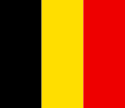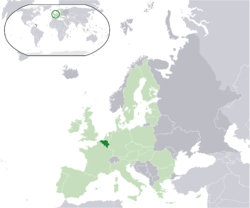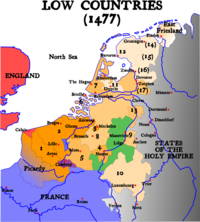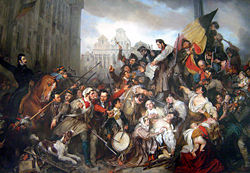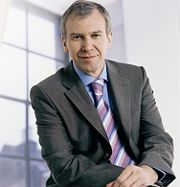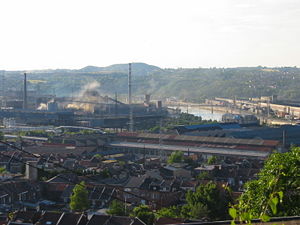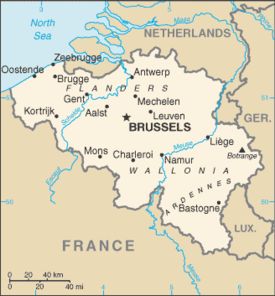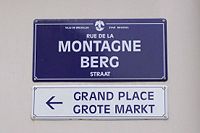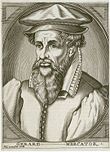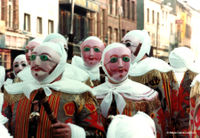Belgium
2008/9 Schools Wikipedia Selection. Related subjects: Europe; European Countries
| Koninkrijk België (Dutch) Royaume de Belgique (French) Königreich Belgien (German) Kingdom of Belgium
|
||||||
|---|---|---|---|---|---|---|
|
||||||
| Motto: Eendracht maakt macht (Dutch) L'union fait la force (French) Einigkeit macht stark (German) "Strength through Unity" (lit. "Unity creates Strength", "Unity makes one strong") |
||||||
| Anthem: The "Brabançonne" |
||||||
|
Location of Belgium (dark green)
– on the European continent (light green & dark grey) |
||||||
| Capital | Brussels |
|||||
| Largest metropolitan area | Brussels Capital Region | |||||
| Official languages | Dutch, French, German | |||||
| Demonym | Belgian | |||||
| Government | Parliamentary democracy and Constitutional monarchy | |||||
| - | King | Albert II | ||||
| - | Prime Minister | Yves Leterme | ||||
| Independence | ||||||
| - | Declared | 4 October 1830 | ||||
| - | Recognized | 19 April 1839 | ||||
| EU accession | 25 March 1957 | |||||
| Area | ||||||
| - | Total | 30,528 km² ( 139th) 11,787 sq mi |
||||
| - | Water (%) | 6.4 | ||||
| Population | ||||||
| - | 2007 estimate | 10,584,534 ( 76th [2005]) |
||||
| - | 2001 census | 10,296,350 | ||||
| - | Density | 344.32/km² ( 2006) (29th [2005]) 892/sq mi |
||||
| GDP ( PPP) | 2004 estimate | |||||
| - | Total | $316.2 billion ( 30th) | ||||
| - | Per capita | $31,400 ( 13th) | ||||
| Gini (2000) | 33 (medium) ( 33rd) | |||||
| HDI (2005) | ▲ 0.946 (high) ( 17th) | |||||
| Currency | Euro ( €)1 ( EU) |
|||||
| Time zone | CET ( UTC+1) | |||||
| - | Summer ( DST) | CEST ( UTC+2) | ||||
| Internet TLD | .be² | |||||
| Calling code | +32 | |||||
| 1 | Before 1999: Belgian franc. | |||||
| 2 | The .eu domain is also used, as it is shared with other European Union member states. | |||||
The Kingdom of Belgium is a country in northwest Europe. It is a founding member of the European Union and hosts its headquarters, as well as those of other major international organizations, including NATO. Belgium covers an area of 30,528 km² (11,787 square miles) and has a population of about 10.5 million.
Straddling the cultural boundary between Germanic and Latin Europe, Belgium's two largest regions are the Dutch-speaking region of Flanders in the north, with 58% of the population, and the French-speaking southern region of Wallonia, inhabited by 32%. The Brussels-Capital Region, although officially bilingual, is a mostly French-speaking enclave within the Flemish Region and near the Walloon Region, and has 10% of the population. A small German-speaking Community exists in eastern Wallonia. Belgium's linguistic diversity and related political and cultural conflicts are reflected in the political history and a complex system of government.
The name 'Belgium' is derived from Gallia Belgica, a Roman province in the northernmost part of Gaul that was inhabited by the Belgae, a mix of Celtic and Germanic peoples. Historically, Belgium, the Netherlands and Luxembourg were known as the Low Countries, which used to cover a somewhat larger area than the current Benelux group of states. From the end of the Middle Ages until the 17th century, it was a prosperous centre of commerce and culture. From the 16th century until the Belgian revolution in 1830, many battles between European powers were fought in the area of Belgium, causing it to be dubbed "the battlefield of Europe" and "the cockpit of Europe" — a reputation strengthened by both World Wars. Upon its independence, Belgium eagerly participated in the Industrial Revolution, generating wealth and also a demand for raw materials; the latter was a factor during the era of its African colonies.
History
The area of present-day Belgium has seen significant demographic, political and cultural upheavals over the course of two millennia. In the first century, the Romans, after defeating the local tribes, created the province of Gallia Belgica. A gradual immigration by Germanic Frankish tribes during the 5th century, brought the area under the rule of the Merovingian kingdom. A gradual shift of power during the 8th century evolved into the Carolingian Empire and culminated with the coronation of Charlemagne as ruler of The Holy Roman Empire. During the Middle Ages small feudal states emerged, many of which rejoined as the Burgundian Netherlands in the 14th and 15th centuries. Emperor Charles V completed the union of the Seventeen Provinces in the 1540s, and unofficially also controlled the Prince-Bishopric of Liège.
The Eighty Years' War (1568–1648) divided the area into the northern United Provinces ('federate' Belgica Foederata in Latin) and the Southern Netherlands ('royal' Belgica Regia). The latter were ruled successively by the Spanish and the Austrian Habsburgs and comprised most of modern Belgium. Until independence the area was sought after by numerous French conquerors and was the theatre of most Franco-Spanish and Franco-Austrian wars during the 17th and 18th centuries. Following the campaigns of 1794 in the French Revolutionary Wars, the Low Countries — including territories that were never nominally under Habsburg rule, such as the Prince-Bishopric of Liège — were annexed by the French First Republic, ending Spanish-Austrian rule in the region. The reunification of the Low Countries as the United Kingdom of the Netherlands occurred at the dissolution of the First French Empire in 1815. However, over the previous 350 years of shared connections as varied Low Country manifestations the two peoples had drifted apart, and after only 15 years, the forced "marriage" was over. The 1830 Belgian Revolution led to the establishment of an independent, Catholic, and neutral Belgium under a provisional government and a national congress. Since the installation of Leopold I as king in 1831, Belgium has been a constitutional monarchy and parliamentary democracy. Initially an oligarchy ruled mainly by the Catholic Party and the Liberals, the country had evolved towards universal suffrage by World War II with the rise of the Belgian Labour Party and trade unions playing a strong role. French, once the single official language and adopted by the nobility and the bourgeoisie, had by then lost its overall importance as Dutch, the language of the majority of the population, had become recognized as well, be it only in 1898. However, it was not until 1967 that an official Dutch version of the Constitution was accepted.
The Berlin Conference of 1885 gave the Congo Free State to King Leopold II as his private possession. In 1908, it was ceded to Belgium as a colony, henceforth called the Belgian Congo. Belgian control of the Congolese population, particularly under Leopold II, was savage, and the country was plundered of resources such as ivory and rubber.
Germany invaded Belgium in 1914 as part of the Schlieffen Plan, and much of the Western Front fighting of World War I occurred in western parts of the country. Belgium took over the German colonies of Ruanda-Urundi (modern day Rwanda and Burundi) during the war, and they were mandated to Belgium in 1924 by the League of Nations, of which it was a founding member. The Treaty of Versailles had subjected several German border towns, most notably Eupen and Malmedy, to a controversial plebiscite, which led to their annexation by Belgium in 1925, thereby causing the presence of a small German community. Belgium was again invaded by Germany in 1940 during the Blitzkrieg offensive, and occupied until its liberation by Allied troops in the winter of 1944–1945. The Belgian Congo gained independence in 1960 during the Congo Crisis; Ruanda-Urundi followed two years later.
After World War II, Belgium joined NATO as a founder member, headquartered at Brussels, and formed the Benelux group of nations with the Netherlands and Luxembourg. Belgium became one of the six founding members of the European Coal and Steel Community in 1951, and of the European Atomic Energy Community and European Economic Community, established in 1957. The latter is now the European Union, for which Belgium hosts major administrations and institutions, including the European Commission, the Council of the European Union, and the extraordinary and committee sessions of the European Parliament.
Government and politics
Belgium is a constitutional, popular monarchy and a parliamentary democracy.
In the 19th century, the Francophile political and economic elite treated the Dutch-speaking population as second class citizens. Late that century, and continuing into the 20th century, the Flemish movement evolved to counter this situation. Following World War II, Belgian politics became increasingly dominated by the autonomy of its two main language communities. Intercommunal tensions rose and even the unity of the Belgian state became scrutinized. Through constitutional reforms in the 1970s and 1980s, regionalization of the unitary state led to a three-tiered federation: federal, regional, and community governments were created, a compromise designed to minimize linguistic, cultural, social and economic tensions.
The federal bicameral parliament is composed of a Senate and a Chamber of Representatives. The former is made up of 40 directly elected politicians and 21 representatives appointed by the 3 community parliaments, 10 coopted senators and as senators by Right who in practice do not cast their vote, currently Prince Philippe, Princess Astrid and Prince Laurent, children of the King. The Chamber's 150 representatives are elected under a proportional voting system from 11 electoral districts. Belgium is one of the few countries that has compulsory voting, and thus holds one of the highest rates of voter turnout in the world.
The King (currently Albert II) is the head of state, though with limited prerogatives. He appoints ministers, including a Prime Minister, that have the confidence of the Chamber of Representatives to form the federal government. The numbers of Dutch- and French-speaking ministers are equal as prescribed by the Constitution. The judicial system is based on civil law and originates from the Napoleonic code. The Court of Cassation is the court of last resort, with the Court of Appeal one level below.
Belgium's political institutions are complex; most political power is organized around the need to represent the main cultural communities. Since around 1970, the significant national Belgian political parties have split into distinct components that mainly represent the political and linguistic interests of these communities. The major parties in each community, though close to the political centre, belong to three main groups: the right-wing Liberals, the socially conservative Christian Democrats, and the Socialists forming the left-wing. Further notable parties came into being well after the middle of last century, mainly around linguistic, nationalist, or environmental themes, and recently smaller ones of some specific liberal nature.
A string of Christian Democrat coalition governments from 1958 was broken in 1999 after the first dioxin crisis, a major food contamination scandal that led to the establishment of the Belgian Food Agency. A 'rainbow coalition' emerged from six parties: the Flemish and the French-speaking Liberals, Social Democrats, Greens. Later, a 'purple coalition' of Liberals and Social Democrats formed after the Greens lost most of their seats in the 2003 election. The government led by Prime Minister Guy Verhofstadt from 1999 to 2007 achieved a balanced budget, some tax-reforms, a labour-market reform, scheduled nuclear phase-out, and instigated legislation allowing more stringent war crime and more lenient soft drug usage prosecution. Restrictions on withholding euthanasia were reduced and same-sex marriage legalized. The government promoted active diplomacy in Africa and opposed the invasion of Iraq. Verhofstadt's coalition fared badly in the June 2007 elections. Since then the country has been experiencing a long-lasting political crisis. This crisis is such that many observers have speculated on a possible partition of Belgium. Since December 21, 2007 the Verhofstadt III Government has been in office. This coalition of the Flemish and Francophone Christian Democrats, the Flemish and Francophone Liberals together with the Francophone Social Democrats was an interim government until 20 March 2008. On that day a new government, led by Flemish Christian Democrat Yves Leterme, the actual winner of the federal elections of June 2007, was sworn in by the King.
In its 2007 Worldwide Press Freedom Index, Reporters Without Borders ranked Belgium (along with Finland and Sweden) 5th out of 169 countries.
Communities and regions
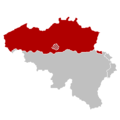 Flemish Community (Dutch-speaking) |
 French Community (French-speaking) |
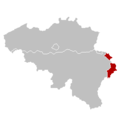 German-speaking Community |
 Flemish Region |
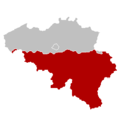 Walloon Region |
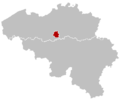 Brussels-Capital Region |
Based on the four language areas defined in 1962–63, consecutive revisions of the country's constitution in 1970, 1980, 1988 and 1993 established a unique federal state with segregated political power into three levels:
- The federal government, based in Brussels.
- The three language communities:
- the Flemish Community (Dutch-speaking);
- the French (i.e., French-speaking) Community;
- the German-speaking Community.
- The three regions:
- the Flemish Region, subdivided into five provinces;
- the Walloon Region, subdivided into five provinces;
- the Brussels-Capital Region.
The constitutional language areas determine the official languages in their municipalities, as well as the geographical limits of the empowered institutions for specific matters:
Although this would allow for seven parliaments and governments, when the Communities and Regions were created in 1980, Flemish politicians decided to merge both; thus in the Flemish Region a single institutional body of parliament and government is empowered for all except federal and specific municipal matters.
The overlapping boundaries of the Regions and Communities have created two notable peculiarities: the territory of the Brussels-Capital Region (which came into existence nearly a decade after the other regions) is included in both the Flemish and French Communities, and the territory of the German-speaking Community lies wholly within the Walloon Region.
Conflicts between the bodies are resolved by the Constitutional Court of Belgium. The structure is intended as a compromise to allow different cultures to live together peacefully.
Political authority
The Federal State retains a considerable "common heritage". This includes justice, defence, federal police, social security, nuclear energy, monetary policy and public debt, and other aspects of public finances. State-owned companies include the Post Office and Belgian Railways. The Federal Government is responsible for the obligations of Belgium and its federalized institutions towards the European Union and NATO. It controls substantial parts of public health, home affairs and foreign affairs.
Communities exercise their authority only within linguistically determined geographical boundaries, originally oriented towards the individuals of a Community's language: culture (including audiovisual media), education, and the use of the relevant language. Extensions to personal matters less directly connected with language comprise health policy (curative and preventive medicine) and assistance to individuals (protection of youth, social welfare, aid to families, immigrant assistance services, etc.).
Regions have authority in fields that can be broadly associated with their territory. These include economy, employment, agriculture, water policy, housing, public works, energy, transport, the environment, town and country planning, nature conservation, credit, and foreign trade. They supervise the provinces, municipalities, and intercommunal utility companies.
In several fields, the different levels each have their own say on specifics. With education, for instance, the autonomy of the Communities neither includes decisions about the compulsory aspect nor allows for setting minimum requirements for awarding qualifications, which remain federal matters. Each level of government can be involved in scientific research and international relations associated with its powers.
Geography, climate, and environment
Belgium shares borders with France (620 km), Germany (167 km), Luxembourg (148 km) and the Netherlands (450 km). Its total area, including surface water area, is 33,990 square kilometres; land area alone is 30,528 km². Belgium has three main geographical regions: the coastal plain in the north-west and the central plateau both belong to the Anglo-Belgian Basin; the Ardennes uplands in the south-east are part of the Hercynian orogenic belt. The Paris Basin reaches a small fourth area at Belgium's southernmost tip, Belgian Lorraine.
The coastal plain consists mainly of sand dunes and polders. Further inland lies a smooth, slowly rising landscape irrigated by numerous waterways, with fertile valleys and the northeastern sandy plain of the Campine (Kempen). The thickly forested hills and plateaus of the Ardennes are more rugged and rocky with caves and small gorges, and offer much of Belgium's wildlife but little agricultural capability. Extending westward into France, this area is eastwardly connected to the Eifel in Germany by the High Fens plateau, on which the Signal de Botrange forms the country's highest point at 694 metres (2,277 ft).
The climate is maritime temperate, with significant precipitation in all seasons ( Köppen climate classification: Cfb). The average temperature is lowest in January at 3 ° C (37 ° F), and highest in July at 18 °C (64 °F). The average precipitation per month varies between 54 millimetres (2.1 in) in February or April, to 78 millimetres (3.1 in) in July. Averages for the years 2000 to 2006 show daily temperature minimums of 7 °C (45 °F) and maximums of 14 °C (57 °F), and monthly rainfall of 74 millimetres (2.9 in); these are about 1 degree Celsius and nearly 10 millimetres above last century's normal values, respectively.
Phytogeographically, Belgium is shared between the Atlantic European and Central European provinces of the Circumboreal Region within the Boreal Kingdom. According to the WWF, the territory of Belgium belongs to the ecoregion of Atlantic mixed forests.
Because of its high population density, location in the centre of Western Europe, and inadequate political effort, Belgium faces serious environmental problems. A 2003 report suggested Belgian rivers to have the lowest water quality of the 122 countries studied. In the 2006 pilot Environmental Performance Index, Belgium scored 75.9% for overall environmental performance and was ranked lowest of the EU member countries , though it was only 39th of 133 countries.
Economy
Belgium's economy and its transportation infrastructure are integrated with the rest of Europe. Its location at the heart of a highly industrialized region helps make it one of the world's ten largest trading nations. The economy is characterized by a highly productive work force, high GNP, and high exports per capita. Belgium's main imports are food products, machinery, rough diamonds, petroleum and petroleum products, chemicals, clothing and accessories, and textiles. Its main exports are automobiles, food products, iron and steel, finished diamonds, textiles, plastics, petroleum products, and nonferrous metals. The Belgian economy is heavily service-oriented and shows a dual nature: a dynamic Flemish economy, with Brussels as its main multilingual and multi-ethnic centre, and a Walloon economy that lags behind. One of the founding members of the European Union, Belgium strongly supports an open economy and the extension of the powers of EU institutions to integrate member economies. In 1999, Belgium adopted the Euro, the single European currency, which fully replaced the Belgian franc in 2002. Since 1922, Belgium and Luxembourg have been a single trade market within a customs and currency union: the Belgium-Luxembourg Economic Union.
Belgium was the first continental European country to undergo the Industrial Revolution, in the early 1800s. Liège and Charleroi rapidly developed mining and steelmaking, which flourished until the mid-20th century in the Sambre- Meuse valley, the sillon industriel. However, by the 1840s the textile industry of Flanders was in severe crisis and the region experienced famine from 1846–50.
After World War II, Ghent and Antwerp experienced a rapid expansion of the chemical and petroleum industries. The 1973 and 1979 oil crises sent the economy into a recession; it was particularly prolonged in Wallonia, where the steel industry had become less competitive and experienced serious decline. In the 1980s and 90s, the economic centre of the country continued to shift northwards and is now concentrated in the populous Flemish Diamond area.
By the end of the 1980s, Belgian macroeconomic policies had resulted in a cumulative government debt of about 120% of GDP. As of 2006, the budget was balanced and public debt was equal to 90.30% of GDP. In 2005 and 2006, real GDP growth rates of 1.5% and 3.0%, respectively, were slightly above the average for the Euro area. Unemployment rates of 8.4% in 2005 and 8.2% in 2006 were close to the area average.
Numismatics
In Belgium, the euro was introduced in 2002. However, the first sets of coins were minted, as preparation, in 1999. Hence the first euro coins of Belgium have minted the year 1999 instead of 2002 like other countries in the eurozone. In order to conform to the common guidelines on the design of national faces of coins, Belgium has updated the design of the Belgian national face of euro coins to be produced from 2008; also adopted the new common map like the rest of the eurozone countries.
Belgium has a rich collection of collectors' coins, with face value ranging from 10 to 100 euro. These coins are a legacy of an old national practice of minting of silver and gold commemorative coins. Unlike normal issues, these coins are not legal tender in all the eurozone. For instance, a €10 Belgian commemorative coin cannot be used in any other country.
While all Belgian coins designated for circulation show the portrait of King Albert II, this does not happen for commemorative coins, where designs are freely chosen.
Demographics
At the start of 2007 nearly 92% of the Belgian population were national citizens, and around 6% were citizens from other European Union member countries. The prevalent foreign nationals were Italian (171,918), French (125,061), Dutch (116,970), Moroccan (80,579), Spanish (42,765), Turkish (39,419), and German (37,621).
Urbanisation
Almost all of the Belgian population is urban — 97% in 2004. The population density of Belgium is 342 per square kilometre (886 per square mile) — one of the highest in Europe, after that of the Netherlands and some microstates such as Monaco. The most densely inhabited area is the Flemish Diamond, outlined by the Antwerp- Leuven-Brussels- Ghent agglomerations. The Ardennes have the lowest density. As of 2006, the Flemish Region had a population of about 6,078,600, with Antwerp (457,749), Ghent (230,951) and Bruges (117,251) its most populous cities; Wallonia had 3,413,978, with Charleroi (201,373), Liège (185,574) and Namur (107.178) its most populous. Brussels houses 1,018,804 in the Capital Region's 19 municipalities, two of which have over 100,000 residents.
Languages
Both the Dutch spoken in Belgium and the Belgian French have minor differences in vocabulary and semantic nuances from the varieties spoken respectively in the Netherlands and France. Many Flemish people still speak dialects of Dutch in their local environment. Walloon, once the main regional language of Wallonia, is now only understood and spoken occasionally, mostly by elderly people. Its dialects, along with those of Picard, are not used in public life.
As no census exists, there are no official statistics on Belgium's three official languages or their dialects. Various criteria, including the language(s) of parents, of education, or the second-language status of foreign born, may affect suggested figures. An estimated 59% of the Belgian population speaks Dutch (often referred to as Flemish), and French is spoken by 40%. Total Dutch speakers are 6.23 million, concentrated in the northern Flanders region, while French speakers comprise 3.32 million in Wallonia and an estimated 0.87 million or 85% of the officially bilingual Brussels-Capital Region. The German-speaking Community is made up of 73,000 people in the east of the Walloon Region; around 10,000 German and 60,000 Belgian nationals are speakers of German. Roughly 23,000 more of German speakers live in municipalities near the official Community.
The Capital Region having bilingual status obliges its authorities to attend to people and organisations in French or Dutch language as these prefer, and to show street names in both languages on the plates, but does not allow a bilingual school as education belongs to either the French Community or the Flemish one. Geographically, it is an enclave in the Flemish Region though near Wallonia. Constitutionally, it is a politically distinct Region, while within its boundaries both the Flemish and French Communities exercise their authority. Until the end of the 19th century the majority of the Capital Regions inhabitants spoke local Brabantian dialects of the Dutch language. However a large-scale Frenchification of Brussels started in 1880 as more and more Dutch-speaking people became bilingual, resulting in a rise of monolingual French-speakers after 1910. Halfway through the 20th century the number of monolingual French-speakers carried the day over bilingual people. Today Dutch is spoken by approximately 150,000 residents of the Brussels-Capital Region, or a 15% minority. Recent immigration has brought its population of foreign origin to 56%. The two largest foreign groups come from two francophone countries: France and Morocco. The first language of roughly half of the inhabitants is not an official one of the Capital Region. Nevertheless, about three out of four residents have the Belgian nationality. In general the population of Brussels is younger and the gap between rich and poor is wider. Brussels also has a large concentration of people of Turkish and Moroccan ancestry, and mainly French-speaking black Africans. Since Belgium does not collect statistics by ethnic background, exact figures are unknown.
In 2006, the Université Catholique de Louvain, the country's largest French-speaking university, published a report with the introduction (here translated): "This issue of Regards économiques is devoted to the demand for knowledge of languages in Belgium and in its three regions (Brussels, Flanders, Wallonia). The surveys show that Flanders is clearly more multilingual, which is without doubt a well known fact, but the difference is considerable : whereas 59% and 53% of the Flemings know French or English respectively, only 19% and 17% of the Walloons know Dutch or English. The measures advocated by the Marshall Plan go towards the proper direction, but are without doubt very insufficient to fully overcome the lag." (This particular 2006–2009 'Marshall Plan' was devised in 2004 and published in 2005 to uplift the Walloon economy.) Within the report, professors in economics Ginsburgh and Weber further show that of the Brussels' residents, 95% declared they can speak French, 59% Dutch, and 41% know the non-local English. Economically significant for a further globalizing future, among people under the age of forty, in Flanders 59%, in Wallonia 10%, and in Brussels 28% can speak all three forementioned languages. In each region, Belgium's third official language, German, is notably less known than those.
Education
Education is compulsory from six to eighteen for Belgians, but many continue to study until about 23 years of age. Among OECD countries in 2002, Belgium had the third-highest proportion of 18–21-year-olds enrolled in postsecondary education, at 42%. Though an estimated 98% of the adult population is literate, concern is rising over functional illiteracy. The Programme for International Student Assessment, coordinated by the OECD, currently ranks Belgium's education as the 19th best in the world, being significantly higher than the OECD average.
Highly politicized conflicts between freethought and Catholic segments of the population during the 1950s caused a split in educational organization. A secular branch of schooling is controlled by the Community, the province, or the municipality, while religious, mainly Catholic branch education, is organized by religious authorities, although subsidized and supervised by the Community.
Religion
Since the country's independence, Roman Catholicism, counterbalanced by strong freethought movements, has had an important role in Belgium's politics. However Belgium is largely a secular country as the laicist constitution provides for freedom of religion, and the government generally respects this right in practice. Nevertheless, the monarchy has a reputation of deeply-rooted Catholicism. In 1990, for instance, as a King constitutionally obliged to sign a law legalizing abortion after it had been passed by both chambers, Baudouin asked the then Christian-Democrat Prime Minister Wilfried Martens to find a way out, causing the Parliament to declare him 'temporarily unfit to reign', with his consent. On the yearly national holiday, the King and Queen and other members of the royal family officially attend Te Deum celebrations.
Symbolically and materially, the Roman Catholic Church remains in a favourable position. Belgium's concept of 'recognized religions' set a path for Islam to follow to acquire the treatment of Jewish and Protestant religions. While other minority religions, such as Hinduism, do not yet have such status, Buddhism took the first steps toward legal recognition in 2007. According to the 2001 Survey and Study of Religion, about 47% of the population identify themselves as belonging to the Catholic Church, while Islam is the second-largest religion at 3.5%. A 2006 inquiry in Flanders, considered to be a more religious region than Wallonia, showed that 55% considered themselves religious, and that 36% believed that God created the world.
According to the most recent Eurobarometer Poll 2005, 43% of Belgian citizens responded that "they believe there is a god", whereas 29% answered that "they believe there is some sort of spirit or life force" and 27% that "they do not believe there is any sort of spirit, god, or life force".
There is also a tiny Hindu and Sikh population. While there are around 8,000 Hindus mostly near Antwerp, most Sikhs (around 10,000) are either in Vilvoorde or Sint-Truiden (see Sikhism in Belgium).
Science and technology
Contributions to the development of science and technology have appeared throughout the country's history. The sixteenth century Early Modern flourishing of Western Europe included cartographer Gerardus Mercator, anatomist Andreas Vesalius, herbalist Rembert Dodoens, and mathematician Simon Stevin among the most influential scientists. In the first half of the seventeenth century, the Walloon method of making bar iron found its way to Sweden where it remained in use for more than two hundred and sixty years.
The quickly developed and dense Belgian railroad system caused major companies like La Brugeoise et Nivelles (now the BN division of Bombardier Transportation) to develop specific technologies, and the economically important very deep coal mining in the course of the First Industrial Revolution has required highly reputed specialized studies for mine engineers.
The end of the nineteenth century and the twentieth saw important Belgian advances in applied and pure science. The chemist Ernest Solvay and the engineer Zenobe Gramme (École Industrielle de Liege) gave their names to the Solvay process and the Gramme dynamo, respectively, in the 1860s. Georges Lemaître (Université Catholique de Louvain) is credited with proposing the Big Bang theory of the origin of the universe in 1927. Three Nobel Prizes in Physiology or Medicine were awarded to Belgians: Jules Bordet ( Université Libre de Bruxelles) in 1919, Corneille Heymans (Universiteit Gent) in 1938, and Albert Claude (Université Libre de Bruxelles) and Christian De Duve (Université Catholique de Louvain) in 1974. Ilya Prigogine (Université Libre de Bruxelles) was awarded the Nobel Prize in Chemistry in 1977.
Culture
Belgian cultural life is concentrated within each language community, and a variety of barriers have made a shared cultural sphere less pronounced. There has been since the 1970s no bilingual universities except the Royal Military Academy, no common media, and no single large cultural or scientific organization in which both main communities are represented. The forces that once held them (the Belgians) together--Roman Catholicism and economic and political opposition to the Dutch-- are no longer strong. Despite its political and linguistic divisions that have been strongly changing during the centuries, the region corresponding to today's Belgium has seen the flourishing of major artistic movements that have had tremendous influence on European art and culture.
Fine arts

by Pieter Brueghel the Elder,
in Vienna's Kunsthistorisches Museum.
Contributions to painting and architecture have been especially rich. The Mosan art, the Early Netherlandish, the Flemish Renaissance and Baroque painting, and major examples of Romanesque, Gothic, Renaissance and Baroque architecture are milestones in the history of art. Famous names in this classic tradition include the Flemish artists Jan van Eyck, Rogier van der Weyden and, Pieter Brueghel the Elder as well as Lambert Lombard and Theodore de Bry from Liège. The historical artistic production of the Flemish before the early seventeenth century Baroque style of Peter Paul Rubens and Anthony van Dyck is often not distinguished from that of the Dutch nor of the Walloons. In the southern Netherlands it gradually declined thereafter, although high quality tapestry continued to be created until well into the eighteenth century.
During the nineteenth and twentieth centuries many original romantic, expressionist and surrealist Belgian painters emerged, including Egide Wappers, James Ensor, Constant Permeke and René Magritte. The avant-garde CoBrA movement appeared in the 1950s, while the sculptor Panamarenko remains a remarkable figure in contemporary art. The multidisciplinary artist Jan Fabre and the painter Luc Tuymans are other internationally renowned figures on the contemporary art scene. Belgian contributions to architecture also continued into the nineteenth and twentieth centuries, including the work of Victor Horta and Henry van de Velde, who were major initiators of the Art Nouveau style.
The vocal music of the Franco-Flemish School developed in the southern part of the Low Countries and was an important contribution to Renaissance culture. The nineteenth and twentieth centuries witnessed the appearance of major violinists, such as Henri Vieuxtemps, Eugène Ysaÿe and Arthur Grumiaux, while Adolphe Sax invented the saxophone in 1846. The composer César Franck was born in Liège in 1822. Belgium has also produced music of contemporary note. The first Belgian singer to successfully pursue an international career is Bobbejaan Schoepen, pioneer of varieté and pop music. Jazz musician Toots Thielemans has achieved global fame, as have the singers Jacques Brel and Italy-born Adamo. In rock/pop music, Telex, Front 242, K's Choice, Hooverphonic, Zap Mama, Soulwax and dEUS are well known.
Belgium has produced several well-known authors, including the poet Emile Verhaeren and novelists Hendrik Conscience, Georges Simenon, Suzanne Lilar and Amélie Nothomb. The poet and playwright Maurice Maeterlinck won the Nobel Prize in literature in 1911. The Adventures of Tintin by Hergé is the best known of Franco-Belgian comics, but many other major authors, including Peyo ( The Smurfs), André Franquin, Edgar P. Jacobs, and Willy Vandersteen brought the Belgian cartoon strip industry on a par with the U.S.A. and Japan.
Belgian cinema, often influenced by the Dutch or French, has brought a number of mainly Flemish novels to life on-screen. The absence of a major Belgian cinema company, however, has forced several talented directors to emigrate, such as Carl Colpaert or participate in low-budget productions such as Marc Didden's Brussels by Night (1983). Other Belgian directors include André Delvaux, Stijn Coninx, Luc and Jean-Pierre Dardenne; well-known actors include Jan Decleir and Marie Gillain; and successful films include Man Bites Dog and The Alzheimer Affair. In the 1980s, Antwerp's Royal Academy of Fine Arts produced important fashion trendsetters, known as the Antwerp Six.
Folklore
Folklore plays a major role in Belgium's cultural life: the country has a comparatively high number of processions, cavalcades, parades, 'ommegangs' and 'ducasses', ' kermesse', and other local festivals, nearly always with an originally religious background. The Carnival of Binche with its famous Gilles, and the 'Processional Giants and Dragons' of Ath, Brussels, Dendermonde, Mechelen and Mons are recognized by UNESCO as Masterpieces of the Oral and Intangible Heritage of Humanity. Other examples are the Carnival of Aalst; the still very religious processions of the Holy Blood in Bruges, Virga Jesse in Hasselt, and Hanswijk in Mechelen; the August 15 festival in Liège; and the Walloon festival in Namur. Originated in 1832 and revived in the 1960s, the Gentse Feesten have become a modern tradition. A major non-official holiday is the Saint Nicholas Day, a festivity for children and, in Liège, for students.
Sports
The 1920 Summer Olympics were held in Antwerp, Belgium.
Football (soccer) and cycling are especially popular. Jean-Marie Pfaff, a former Belgian goalie, is considered one of the greatest goalkeepers (soccer) in the history of the game.. With five victories in the Tour de France and numerous other cycling records, Belgian Eddy Merckx ranks #1 as the greatest cyclist of all time. His hour speed record (set in 1972) stood for twelve years. Either Kim Clijsters or Justine Henin, two Belgian tennis champions, are consistently listed as the Top Professional Female.
The Spa-Francorchamps motor-racing circuit hosts the Formula One World Championship Belgian Grand Prix. The Belgian driver, Jacky Ickx, has won eight Grands Prix and six 24 Hours of Le Mans, and twice finished as runner-up in the Formula One World Championship. Thierry Boutsen also won three races in 1989 and 1990. Belgium also has a strong reputation in motocross; world champions include Roger De Coster, Joël Robert, Georges Jobé, Eric Geboers, Joël Smets and Stefan Everts.
Belgium has played a major part in the promotion and development of Duathlon. More specifically Benny Vansteelant has made a lasting legacy conquering a stunning 8 World Champion titles and 5 European Champion titles.
Belgium is currently bidding with the Netherlands to host the 2018 World Cup. Both countries previously hosted the UEFA European Football Championship in 2000. Belgium also hosted the European Football Championships in 1972.
Cuisine
Belgium is well known the world over for its cuisine. Many highly ranked restaurants can be found in the most influential gastronomic guides, such as the Michelin Guide. Belgian food is, like the country itself, a mix of Germanic and Latin influences. Belgians have a reputation for loving waffles and french fries; contrary to the name of the latter, both dishes originated in Belgium. The national dishes are " steak and fries with salad", and " mussels with fries". A challenge issued by a television program elicited no less than 307 different local or regional dishes, presented on a 118-metre long table in Tivoli Park in Mechelen on 1 September 2007.
Brands of Belgian chocolate and pralines, like Callebaut, Côte d'Or, Neuhaus, Leonidas, Guylian and Godiva, are world renowned and widely sold.
Belgium produces over 500 varieties of beer. The biggest brewer in the world by volume is InBev based in Belgium.
